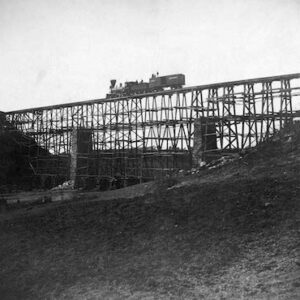| Credit: | by Russell (Andrew J.) |
|---|---|
| Date: | 1863.02-03 |
| Negative Size: | 6.5 in. x 8.5 in. |
| Locations & Lines: | Aquia Creek & Fredericksburg Railroad (AC&F); Potomac Creek VA; Virginia |
| Military Units: | US Military Railroads (USMRR); US Army |
| Structures & Establishments: | AC&F Bridge (a) (Potomac Creek VA) |
| Sources: | Huntington Library; J. Paul Getty Museum; Lehigh University; Library of Congress |
$5.99
File Details: AAAKm, 600 DPI, TIFF, Original Photograph, 16.9 Mb
Image ID: AAAK
Haupt, United States Military Railway Department. Construction And Transportation. No. 11, 12, 13. Military Railroad Bridge across Potomac Creek, on the Fredericksburg Railroad. – Length, 400 feet; height, 80 feet, in four stories.
Major-General McDowell, in his defence before the Court of Inquiry, made the following statement in regard to the Potomac Creek Bridge, on the line of the Richmond, Fredericksburg, and Potomac Railroad:
“The large railroad bridge over the Rappahannock, some 600 feet long by 65 feet high, and the larger part of the one over Potomac creek, some 400 feet long by 80 feet high, were built from the trees cut down by the troops in the vicinity, and this without those troops losing their discipline or their instruction as soldiers. The work they did excited, to a high degree, the wonder and admiration of several distinguished foreign officers, who had never imagined such constructions possible by such means, and in such a way, in the time in which they were done.”
“The Potomac Run Bridge is a most remarkable structure. When it is considered that in the campaigns of Napoleon, trestle bridges of more than one story, even of moderate height, were regarded as impracticable, and that, too for common military roads, it is not difficult to understand why distinguished Europeans should express surprise at so bold a specimen of American military engineering. It is a structure which ignores all the rules and precedents of military science as laid down in books. It is constructed chiefly of round sticks cut from the woods, and not even divested of bark; the legs of the trestles are braced with round poles. It is in four stories, three of trestles and one of crib work. The total height from the deepest part of the stream to the rail, is nearly 80 feet. It carries daily from 10 to 20 heavy railway trains in both directions, and has withstood several severe freshets and storms without injury.
“This bridge was built in May, 1862, in nine working days, during which time the greater part of the material was cut and hauled. It contains more than two million feet of lumber. The original structure, which it replaced, required as many months as this did days. It was constructed by the common soldiers of the Army of the Rappahannock, (command of Major General McDowell,) under the supervision of his aide-de-camp Colonel, now Brigadier General Herman Haupt, Chief of Railroad Construction and Transportation.”



